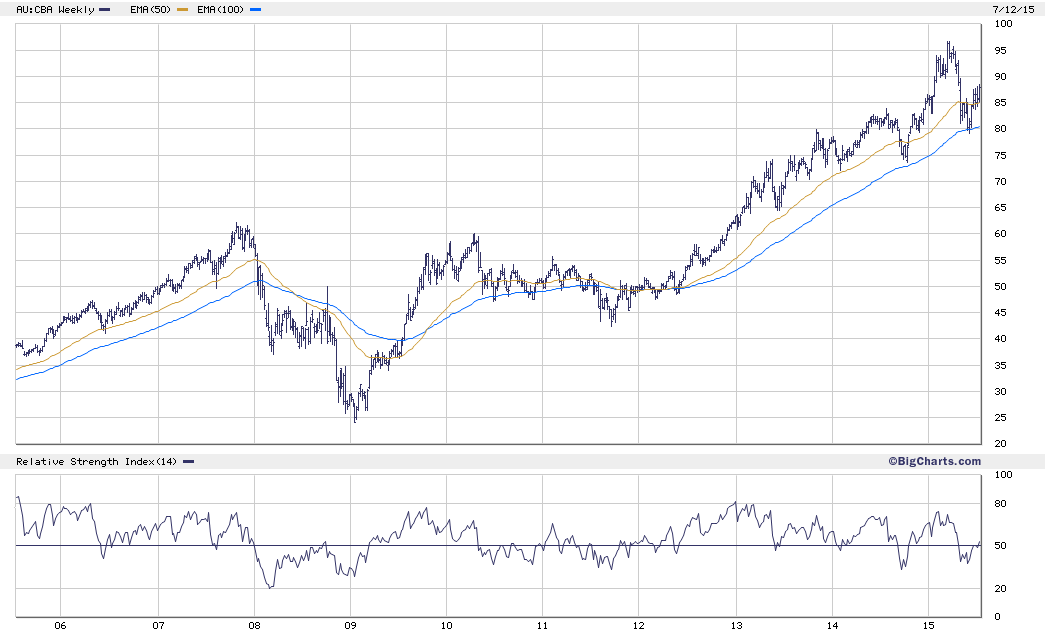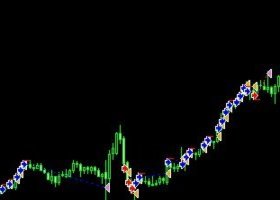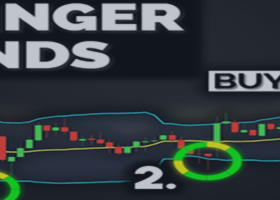What’s Good For the Commonwealth Bank… | |||
By Greg Canavan in Albert Park Friday, July 17th, 2015 --It’s time to check in on our Aussie bellwether stock, the Commonwealth Bank [ASX:CBA]. As I’ve said a few times in the past, the CBA is a great representation of the Aussie economy. --Yes, it’s a well run company and all that other clichéd stuff. But let’s not pretend it’s making its own way. The CBA is a beneficiary of the secular decline in interest rates over the past few decades and Australia’s deformed economic structure that has resulted from this rate decline. --Add in the one-off windfall from the China boom (now fast declining), which Aussies leveraged up to speculate on property, and you can see why the CBA has had a pretty good run over the past decade. Let’s have a look at its share price performance…
--As you can see, CBA is still in a strong long term uptrend. The global credit crisis and its after-affects took some time to shake off. The correction during 2010 and 2011 occurred because the RBA increased interest rates during that time. --But when the rate cutting cycle kicked in in late 2011, CBA’s share price took off. Moreover, the rate cutting cycle kicked off a wave of speculation in the residential property market. --The effects on CBA were two fold. Firstly, lower interest rates reduced the attractiveness of cash and then fixed interest and increased the demand for dividend paying stocks like the CBA. --CBA traded on a dividend yield of around 7% before the rate cuts kicked in. Now, the yield is around 4.9%. This ‘yield compression’ represents capital appreciation of around 40%. --Now throw in low interest rate induced borrowing to engage in property speculation, which is a highly profitable business for CBA, and you get profit growth and dividend increases as well as this yield compression. --Lending against residential property is very profitable for the banks because they only have to set aside a small amount of capital for each loan written. For every $100 lent out, the big banks only have to ‘back’ that loan with a few dollars of equity capital. --That’s partly because of lax prudential lending rules around residential property (it’s considered nearly risk-free) and partly because the big banks get to make their own rules on how much capital they should set aside. --The result is they set aside as little as possible. That is why the CBA has a world beating return on equity of around 18%. The bank is very profitable. And the bank is very profitable because the amount of equity it holds is tiny compared to the company’s assets. That is, it’s highly leveraged. --The point here is that everything has combined over the past few years to provide a healthy tailwind for CBA. As well as the monetary policy tailwind, the government has pitched in to lend a helping hand. --One of the main reasons why Australia’s economy is so structurally unsound is that the tax system encourages property speculation at the expense of productivity enhancing investment. --One of the most egregious examples of this is the policy of negative gearing. The original intention was to encourage investment to expand the housing stock. But all it did was encourage speculation in existing housing. The policy has been a total failure. --Even the RBA recognises this, although it’s about a decade too late. From the Financial Review:
--The RBA is all of a sudden concerned about negative gearing because it realises monetary policy is doing little to help the real economy. It mainly benefits property speculators. --The bank clearly wants to lower rates again but doesn’t want to risk future financial stability by blowing the housing bubble even higher. So now it’s weighing in on tax policy. --It’s all too late of course. And the government has no intention of ending the negative gearing gravy train. Most politicians are in on the rort and they know the electorate has no appetite for structural reform, that is, changing the tax system to change the structure of the economy. --As well as the RBA, the banking regulator, APRA, is coming to the party when everyone is already legless. As the Australian reports:
--‘Tools it could use’? Wow, that’s strong stuff. To continue the party metaphor, APRA has rocked up to the scene with a bottle of mineral water. Clearly, they’re a laughing stock and command little respect from the hard core party element. --Don’t take my word for it though. The market is saying the same thing. Check out the CBA share price again. It’s trading around $87, which is not too far from its all-time highs. --The recent share price bounce suggests investors aren’t duly concerned about regulatory risk. But they are eyeing another interest rate cut and drooling at all the benefits that it will bring. --On the other hand, the bear in me says that CBA’s share price could be topping out. China’s slowing economy and the iron ore price crash are slowly working their way through to the heart of the Aussie economy — the banks. --More interest rate cuts could forestall any effect on profits for another year or two. So the burden of proof is on the bears. Keep one eye on the $80 level for CBA. If the share price turns back down and breaks through it, it will be a win for the bears. --From there, a further fall below the October 2014 low of around $74 would be much more ominous. --But that’s a long way away. For now, the bulls are in control. This tells you Australia’s structurally deformed, low interest rate and asset price dependent economy is holding up on the fumes of easy money. --As I said, if you want to know when this fragile structure will finally give way, keep an eye on CBA. It will provide warning ahead of time. Regards, Greg Canavan+, |




